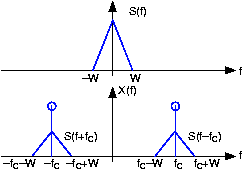| << Chapter < Page | Chapter >> Page > |
The only difficulty in calculating the Fourier transform of any signal occurs when we have periodic signals (in eitherdomain). Realizing that the Fourier series is a special case of the Fourier transform, we simply calculate the Fourier seriescoefficients instead, and plot them along with the spectra of nonperiodic signals on the same frequency axis.
| Time-Domain | Frequency Domain | |
|---|---|---|
| Linearity | ||
| Conjugate Symmetry | ||
| Even Symmetry | ||
| Odd Symmetry | ||
| Scale Change | ||
| Time Delay | ||
| Complex Modulation | ||
| Amplitude Modulation by Cosine | ||
| Amplitude Modulation by Sine | ||
| Differentiation | ||
| Integration | if | |
| Multiplication by | ||
| Area | ||
| Value at Origin | ||
| Parseval's Theorem |
In communications, a very important operation on a signal is to amplitude modulate it. Using this operation more as an example rather than elaborating the communicationsaspects here, we want to compute the Fourier transform — the spectrum — of Thus, For the spectrum of , we use the Fourier series. Its period is , and its only nonzero Fourier coefficients are . The second term is not periodic unless has the same period as the sinusoid. Using Euler's relation, the spectrum of the second term can be derived as Using Euler's relation for the cosine, Exploiting the uniqueness property of the Fourier transform,we have

Note how in this figure the signal is defined in the frequency domain. To find its time domain representation, we simply use the inverse Fourier transform.
What is the signal that corresponds to the spectrum shown in the upper panel of [link] ?
The signal is the inverse Fourier transform of thetriangularly shaped spectrum, and equals
What is the power in , the amplitude-modulated signal? Try the calculation inboth the time and frequency domains.
The result is most easily found in the spectrum's formula: the power in the signal-related part of is half the power of the signal .
In this example, we call the signal a baseband signal because its power is contained at low frequencies. Signals such as speech and the Dow Jonesaverages are baseband signals. The baseband signal's bandwidth equals , the highest frequency at which it has power. Since 's spectrum is confined to a frequency band not close to the origin(we assume ), we have a bandpass signal . The bandwidth of a bandpass signal is not its highest frequency, but the range of positive frequencies wherethe signal has power. Thus, in this example, the bandwidth is . Why a signal's bandwidth should depend on its spectral shape will become clear once we developcommunications systems.

Notification Switch
Would you like to follow the 'Fundamentals of electrical engineering i' conversation and receive update notifications?